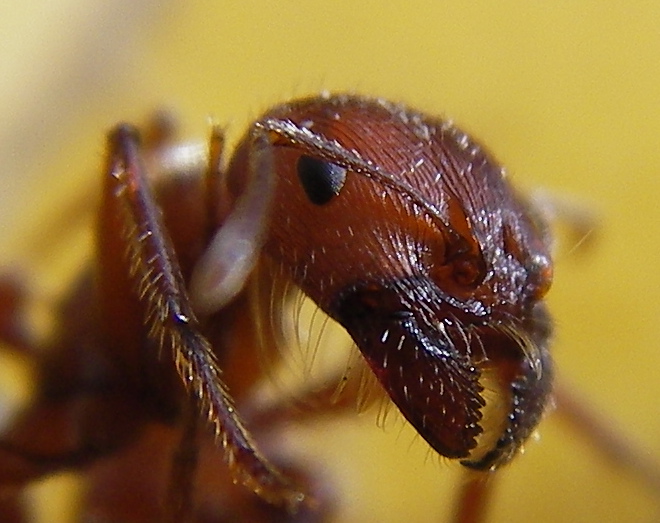|
| 질의: pogonomyrmex | 결과: 2번째/11 | |
Red Harvester Ant (Pogonomyrmex barbatus) - Wiki
| 제목: | Red Harvester Ant (Pogonomyrmex barbatus) - Wiki
| |

| 해상도: 660x523
파일크기: 138667 Bytes
촬영일: 2005:11:27 09:42:16
사진기: PENTAX Optio WP (PENTAX Corporation)
F number: f/3.4
Exposure: 10/3200 sec
Focal Length: 63/10
등록시간: 2007:09:06 23:59:51
|
Red harvester ant
From Wikipedia, the free encyclopedia
[Photo] Red Harvester Ant (Pogonomyrmex barbatus). Date Nov 27, 2005. Author jurvetson
The red harvester ant (Pogonomyrmex barbatus) is a large (5 mm - 7 mm) ant common in the southwest United States.
Physiology
Their chief food source usually consists of seeds, which they hoard in great numbers, hence their name. As with most ant species, their mating castes consist of winged alates (reproductives) that reside in the nest until weather permits them to fly away and mate, after which the male usually dies, and the now-fertilized queen returns to the ground to search for a suitable nesting site. Once she has chosen a spot, she sheds her wings and begins to reproduce, expanding her new colony. She will reproduce "worker ants" for 10-15 years until her death. Red Harvester Ants can be aggressive and have a painful sting that spreads through the lymph nodes, sometimes causing reactions, especially in those allergic to their venom. In addition to their potent sting, Red Harvester ants can bite ferociously. Over the years their numbers have been declining, and this has often been attributed to competition for food with the invasive Red Imported Fire Ant. Their decline has affected many native species, as the red harvester ant is a chief source of food for certain animals such as the Texas horned lizard. Red Harvester Ants are often mistaken for fire ants, but are not related to any fire ant species, native or introduced. As they are indigenous, non-invasive insects that are an important food supply for many larger animals, they should not be treated with insecticides or otherwise exterminated unless they are found to be a problem in that particular area.
Red harvester ant nests are characterized by a lack of foliage and small pebbles surrounding a hole that is usually at grade. The mounds are typically flat and broad, ranging from 0-100 mm high, and 300-1200 mm in diameter. There have been reports of even larger denuded areas, on the order of 10 m². In grassland areas, like ranches, the lack of plant life makes red harvester ant colonies very easy to spot.
http://en.wikipedia.org/wiki/Red_harvester_ant
| The text in this page is based on the copyrighted Wikipedia article shown in above URL. It is used under the GNU Free Documentation License. You may redistribute it, verbatim or modified, providing that you comply with the terms of the GFDL. |
|
^o^
동물그림창고 똑똑전화 누리집
^o^
|
|

